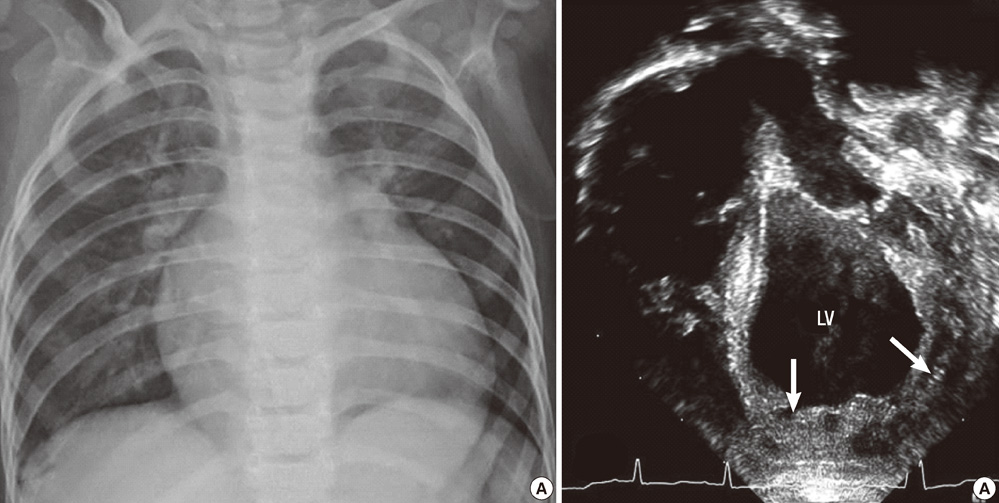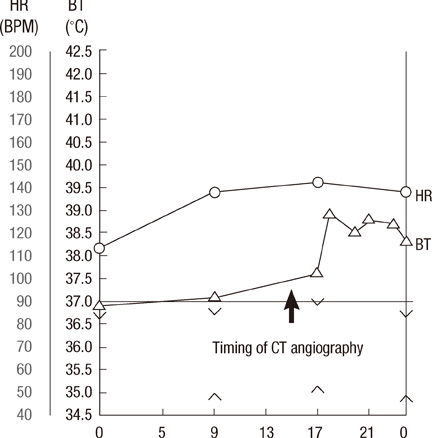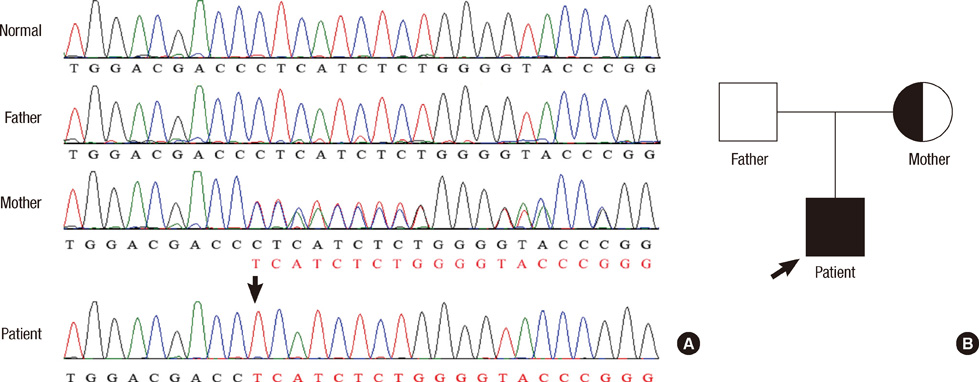J Korean Med Sci.
2013 May;28(5):784-787. 10.3346/jkms.2013.28.5.784.
A Novel Mutation of the TAZ Gene in Barth Syndrome: Acute Exacerbation after Contrast-Dye Injection
- Affiliations
-
- 1Department of Pediatrics, Seoul National University Children's Hospital, Seoul, Korea. cielcel0@snu.ac.kr
- 2Department of Laboratory Medicine, Seoul National University Children's Hospital, Seoul, Korea.
- KMID: 1777570
- DOI: http://doi.org/10.3346/jkms.2013.28.5.784
Abstract
- A 14-month-old boy was transferred because of dilated and hypertrophied left ventricle, neutropenia, and developmental delay. After checking computed tomographic angiography with contrast-dye, the patient showed acute exacerbation and finally died from multi-organ failure despite intensive cares. From genetic analysis, we revealed that the patient had Barth syndrome and found a novel hemizygous frame shift mutation in his TAZ gene, c.227delC (p.Pro76LeufsX7), which was inherited from his mother. Herein, we report a patient with Barth syndrome who had a novel mutation in TAZ gene and experienced unexpected acute exacerbation after contrast dye injection for computed tomographic angiography.
Keyword
MeSH Terms
-
Acidosis/etiology
Acute Disease
Adolescent
Barth Syndrome/diagnosis/*genetics
Contrast Media/adverse effects/*diagnostic use
Frameshift Mutation
Heart Failure/etiology
Homozygote
Humans
Male
Mutation
Pedigree
Sequence Analysis, DNA
Tomography, X-Ray Computed
Transcription Factors/*genetics
Contrast Media
Transcription Factors
Figure
Reference
-
1. Barth PG, Scholte HR, Berden JA, Van der Klei-Van Moorsel JM, Luyt-Houwen IE, Van't Veer-Korthof ET, Van der Harten JJ, Sobotka-Plojhar MA. An X-linked mitochondrial disease affecting cardiac muscle, skeletal muscle and neutrophil leucocytes. J Neurol Sci. 1983. 62:327–355.2. Kelley RI, Cheatham JP, Clark BJ, Nigro MA, Powell BR, Sherwood GW, Sladky JT, Swisher WP. X-linked dilated cardiomyopathy with neutropenia, growth retardation, and 3-methylglutaconic aciduria. J Pediatr. 1991. 119:738–747.3. Barth PG, Valianpour F, Bowen VM, Lam J, Duran M, Vaz FM, Wanders RJ. X-linked cardioskeletal myopathy and neutropenia (Barth syndrome): an update. Am J Med Genet A. 2004. 126A:349–354.4. Takeda A, Sudo A, Yamada M, Yamazawa H, Izumi G, Nishino I, Ariga T. Eponym: Barth syndrome. Eur J Pediatr. 2011. 170:1365–1367.5. Spencer CT, Bryant RM, Day J, Gonzalez IL, Colan SD, Thompson WR, Berthy J, Redfearn SP, Byrne BJ. Cardiac and clinical phenotype in Barth syndrome. Pediatrics. 2006. 118:e337–e346.6. Fanning NF, Manning BJ, Buckley J, Redmond HP. Iodinated contrast media induce neutrophil apoptosis through a mitochondrial and caspase mediated pathway. Br J Radiol. 2002. 75:861–873.7. Schlame M, Ren M. Barth syndrome, a human disorder of cardiolipin metabolism. FEBS Lett. 2006. 580:5450–5455.
- Full Text Links
- Actions
-
Cited
- CITED
-
- Close
- Share
- Similar articles
-
- Identification of a Novel De Novo Mutation of the TAZ Gene in a Korean Patient with Barth Syndrome
- Left Ventricular Noncompaction Complicated with Myocardial Infarction with Barth Syndrome in a Newborn
- Anaphylaxis and Acute Coronary Syndrome Secondary to Intravenous Gadolinium-based Contrast Agent: Kounis Syndrome
- Noonan Syndrome Confirmed to KRAS Gene Mutation: A Case of KRAS Gene Mutation
- Accuracy of Ultrasound Guided Hip Trochanteric Bursa Injection




